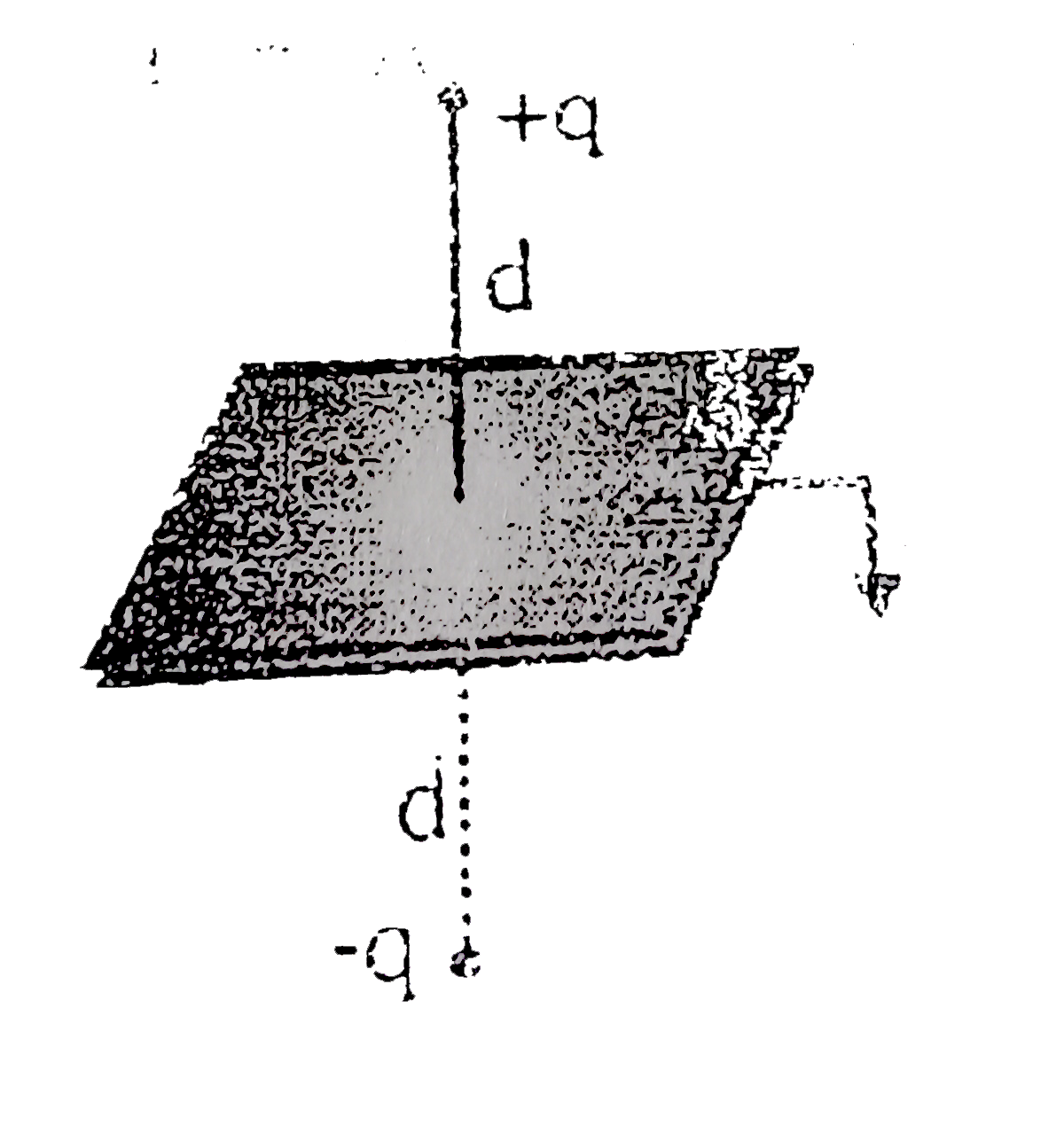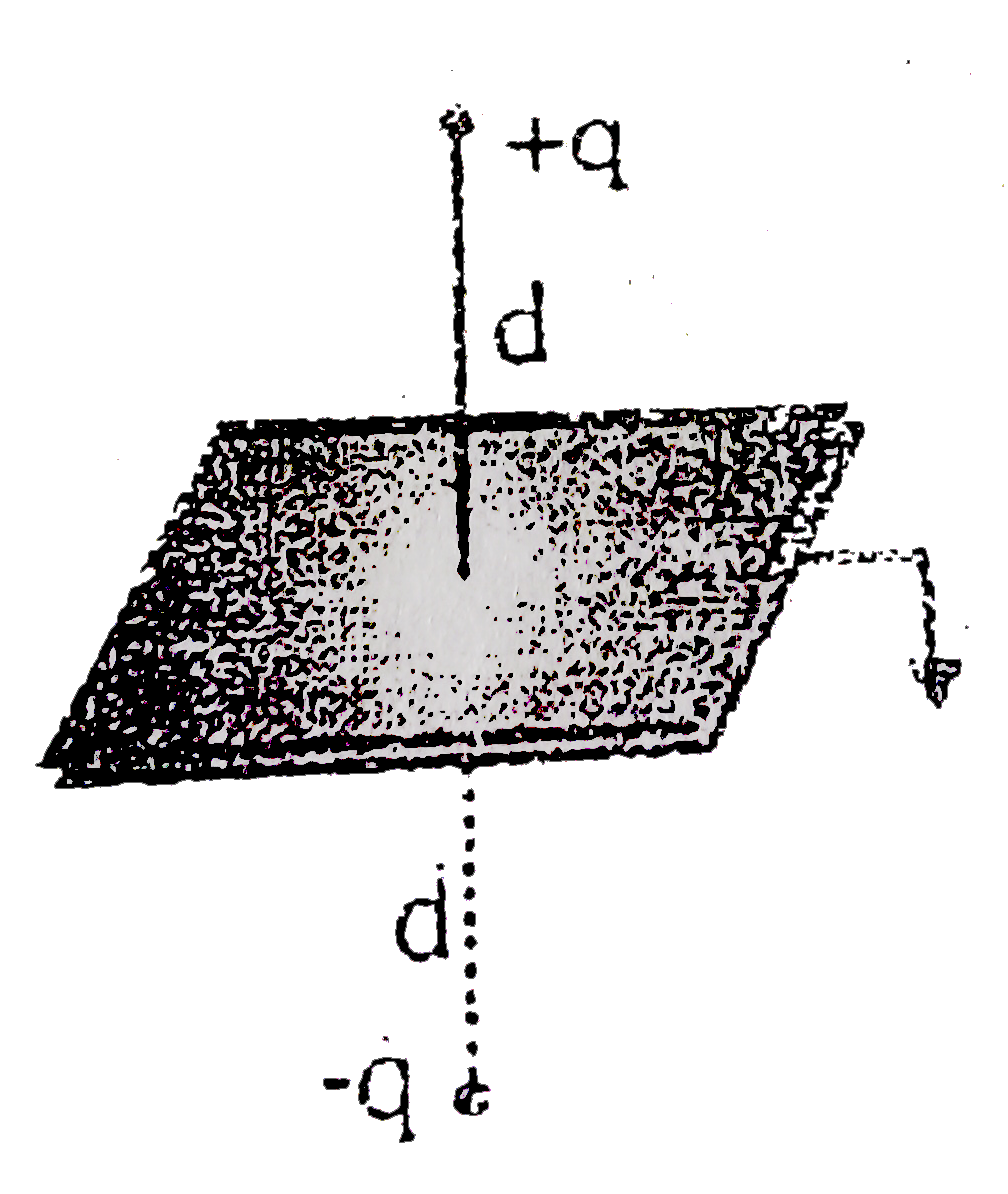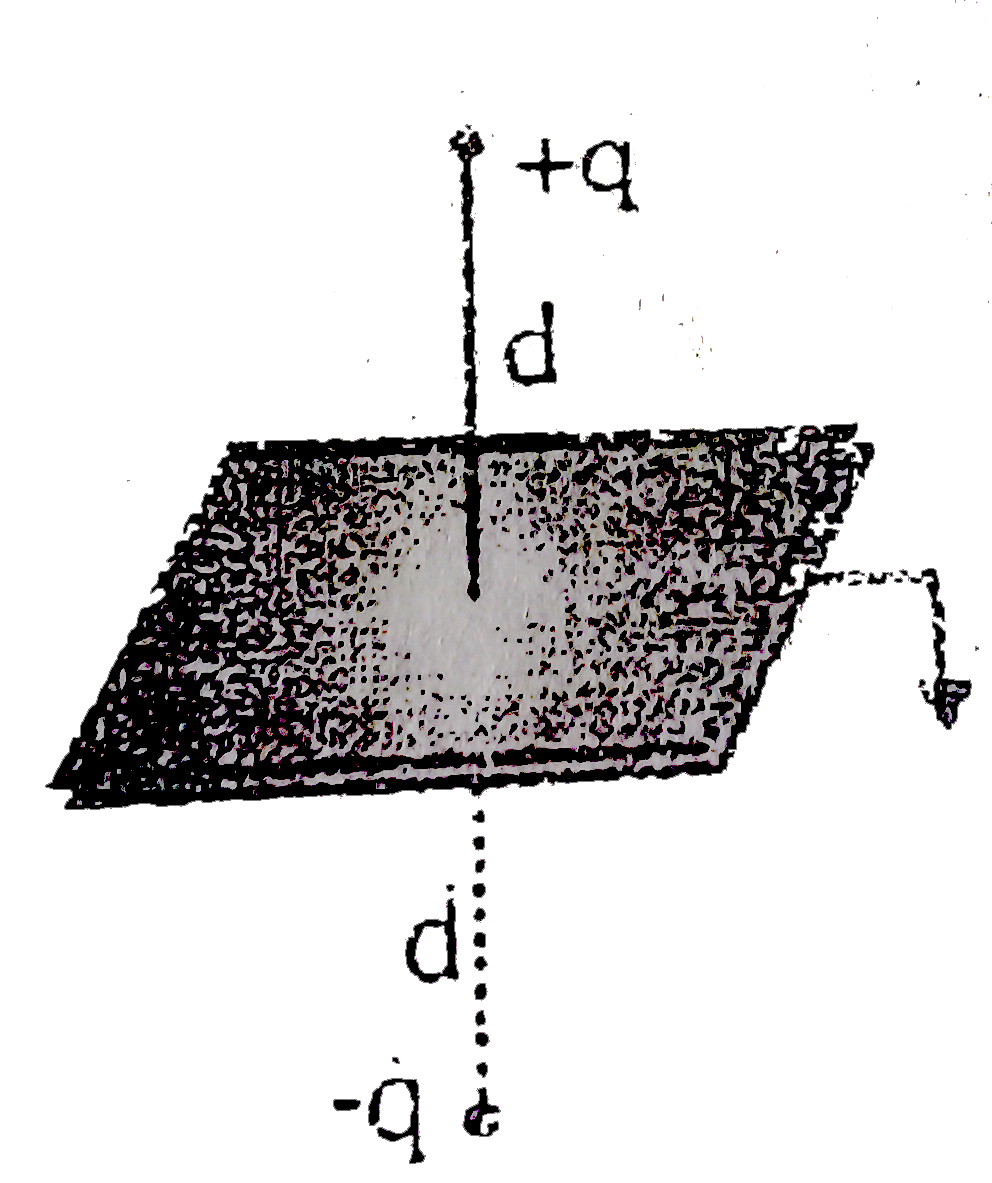A point charge +q, is placed at a distance d from an isolated conducting plane. The field at a point P on the other side of the plane is
directed perpendicular to the plane and away from the plane.
directed perpendicular to the plane but towards the plane.
directed radially away from the point charge.
directed radially towards the point charge.
The correct Answer is:A
To solve the problem of finding the electric field at a point P on the other side of an isolated conducting plane, when a point charge +q is placed at a distance d from the plane, we can follow these steps:
1. Understanding the Setup:
- We have a point charge +q located at a distance d from an isolated conducting plane.
- The conducting plane will respond to the electric field created by the point charge.
2. Induction of Charges on the Conducting Plane:
- The presence of the positive charge +q will induce a negative charge (-q) on the side of the conducting plane that is closest to the charge.
- Consequently, a positive charge (+q) will appear on the opposite side of the conducting plane due to the conservation of charge.
3. Using the Method of Images:
- To analyze the electric field on the side of the conducting plane where point P is located, we can use the method of images.
- We replace the conducting plane with an imaginary point charge -q located at a distance d on the opposite side of the plane.
4. Electric Field Calculation:
- The electric field at point P due to the point charge +q and the imaginary charge -q can be calculated.
- The electric field due to a point charge is given by the formula:
E=k⋅|Q|r2
where k is Coulomb's constant, Q is the charge, and r is the distance from the charge to the point where the field is being calculated.
5. Direction of the Electric Field:
- The electric field due to the positive charge +q at point P will be directed away from the charge.
- The electric field due to the negative charge -q will be directed towards the charge.
- Since point P is on the opposite side of the conducting plane, the net electric field at point P will be directed perpendicular to the plane and away from it.
6. Conclusion:
- The electric field at point P is directed perpendicular to the conducting plane and away from it.
Final Answer:
The electric field at point P on the other side of the conducting plane is directed perpendicular to the plane and away from it.
- We have a point charge +q located at a distance d from an isolated conducting plane.
- The conducting plane will respond to the electric field created by the point charge.
- The presence of the positive charge +q will induce a negative charge (-q) on the side of the conducting plane that is closest to the charge.
- Consequently, a positive charge (+q) will appear on the opposite side of the conducting plane due to the conservation of charge.
- To analyze the electric field on the side of the conducting plane where point P is located, we can use the method of images.
- We replace the conducting plane with an imaginary point charge -q located at a distance d on the opposite side of the plane.
- The electric field at point P due to the point charge +q and the imaginary charge -q can be calculated.
- The electric field due to a point charge is given by the formula:
E=k⋅|Q|r2
where k is Coulomb's constant, Q is the charge, and r is the distance from the charge to the point where the field is being calculated.
- The electric field due to the positive charge +q at point P will be directed away from the charge.
- The electric field due to the negative charge -q will be directed towards the charge.
- Since point P is on the opposite side of the conducting plane, the net electric field at point P will be directed perpendicular to the plane and away from it.
- The electric field at point P is directed perpendicular to the conducting plane and away from it.
The electric field at point P on the other side of the conducting plane is directed perpendicular to the plane and away from it.
Topper's Solved these Questions
- ELECTRIC CHARGES AND FIELDSBOOK - NCERT FINGERTIPSCHAPTER - ELECTRIC CHARGES AND FIELDSEXERCISE - EXEMPLAR PROBLEMS
1 Videos
- ELECTRIC CHARGES AND FIELDSBOOK - NCERT FINGERTIPSCHAPTER - ELECTRIC CHARGES AND FIELDSEXERCISE - Assertion And Reason
15 Videos
- ELECTRIC CHARGES AND FIELDSBOOK - NCERT FINGERTIPSCHAPTER - ELECTRIC CHARGES AND FIELDSEXERCISE - Higher Order Thinking Skills
7 Videos
- DUAL NATURE OF RADIATION AND MATTER BOOK - NCERT FINGERTIPSCHAPTER - DUAL NATURE OF RADIATION AND MATTER EXERCISE - Assertion And Reason
15 Videos
- ELECTROMAGNETIC INDUCTIONBOOK - NCERT FINGERTIPSCHAPTER - ELECTROMAGNETIC INDUCTIONEXERCISE - Assertion And Reason
15 Videos
Similar Questions
A point charge q is located at a distance l from an infinite conduting plane. Determine the surface density of charges induced on the plane as a function of separaction r from the base of the perpendicular drawn to the plane from the chagre.
View SolutionA point charge q is located at a distance l from an infinite tonducting plane. Find the interaction energy of that charge with chose induced on the plane.
View Solution
Knowledge Check
A point charge +q, is placed at a distance d from an isolated conducting plane. The field at a point P on the other side of the plane is
Adirected perpendicular to the plane and away from the plane.Bdirected perpendicular to the plane but towards the plane.Cdirected radially away from the point charge.Ddirected radially towards the point charge.A point charge +q is placed at a distance d from an isolated conducting placen. The field at a point P on the other side of the place is:
Adirected perpendicular to the plane and away from the plane.Bdirected perpendicular to the plane but towards the plane.Cdirected radially away from the point chargeDdirected radially towards the point charge.A point charge +q is placed at a distance d from an isolated conducting plane. The field at a point P on the other side of plane is
Adirected perpendicular to the plane away from the planeBdirected perpendicular to the plane but towards the planeCdirected radially away from the point chargeDdirected radially towards the point charge
A point charge q is located at a distance l from the infinite conducting plane. What amount of work has to be performed in order to slowly remove this charge very far from the plane.
View SolutionThe method of electrical images is used to solve the electrostatic problems, where charge distribution is not specified completely. The method consists of replacement of given charge distribution by a simplified charge distribution or a signal point charge or a number of point charges [rovided the original boundary conditions are still satisfied. For example consider a system consider a system containing a point charge q placed at a distance d of form an infinite conducting plane. The boundary conditions are :
(i) Potential is zero at infinity (ii) Potential is zero at each point on the conducting plane If we replaced the conducting plane by a point charge (-q) placed at a distance 'd' opposite to conducting plane. The charge (-q) is called the electrical image.
Now system consists of two charge +q an -q at seperation2d. If charge +q moves to a distance 'y' from the boundary of conducting plane (now absent), the electrical image -q also moves to the same 'y' from the boundary of conducting plane, so that the new distance between +q and -q is 2y

The work done in carrying charge q from distance d to distance y from earthed conducting plane is
View SolutionThe method of electrical images is used to solve the electrostatic problems, where charge distribution is not specified completely. The method consists of replacement of given charge distribution by a simplified charge distribution or a signal point charge or a number of point charges [rovided the original boundary conditions are still satisfied. For example consider a system consider a system containing a point charge q placed at a distance d of form an infinite conducting plane. The boundary conditions are :
(i) Potential is zero at infinity (ii) Potential is zero at each point on the conducting plane If we replaced the conducting plane by a point charge (-q) placed at a distance 'd' opposite to conducting plane. The charge (-q) is called the electrical image.
Now system consists of two charge +q an -q at seperation2d. If charge +q moves to a distance 'y' from the boundary of conducting plane (now absent), the electrical image -q also moves to the same 'y' from the boundary of conducting plane, so that the new distance between +q and -q is 2y

The potential energy of system of charge +q placed at a distance d from the earthed conducting plane is
View SolutionThe method of electrical images is used to solve the electrostatic problems, where charge distribution is not specified completely. The method consists of replacement of given charge distribution by a simplified charge distribution or a signal point charge or a number of point charges [rovided the original boundary conditions are still satisfied. For example consider a system consider a system containing a point charge q placed at a distance d of form an infinite conducting plane. The boundary conditions are :
(i) Potential is zero at infinity (ii) Potential is zero at each point on the conducting plane If we replaced the conducting plane by a point charge (-q) placed at a distance 'd' opposite to conducting plane. The charge (-q) is called the electrical image.
Now system consists of two charge +q an -q at seperation2d. If charge +q moves to a distance 'y' from the boundary of conducting plane (now absent), the electrical image -q also moves to the same 'y' from the boundary of conducting plane, so that the new distance between +q and -q is 2y

The force between point charge +q and earthed conducting plane is
View SolutionA point charge q is placed at a distance of r from cebtre of an uncharged conducting sphere of rad R(<r). The potential at any point on the sphere is
View Solution
